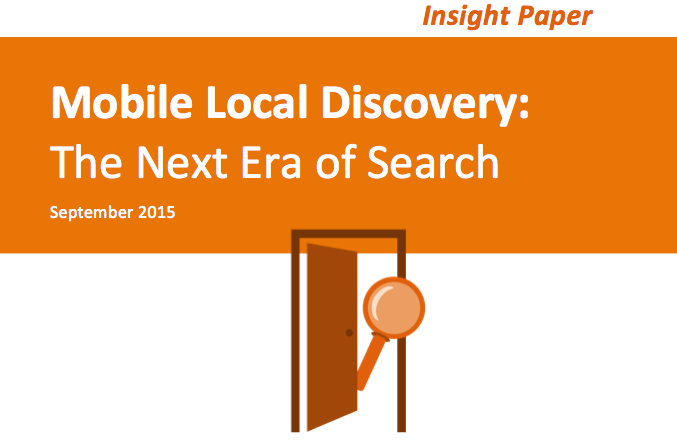
This post is the latest in a weekly series of excerpts from BIA/Kelsey’s recent report Mobile Local Discovery, The Next Era of Search. The series will lead up to BIA/Kelsey NEXT, a conference on the future of local, taking place December 9th & 10th in Los Angeles.
What happens to search when the browser is no longer the front door? As engagement migrates to mobile, users’ front door is predominantly apps instead of the search-centric web. This is the topic of a new BIA/Kelsey report, Mobile Local Discovery, The Next Era of Search.
Search started in the desktop-heavy world of the 90’s and 2000’s, when trillions of web pages compelled an advanced index and a friendly entry point. But an app-centric mobile universe — pre-organized into neat little buckets — doesn’t compel a search engine, as we know it.
Our report looks at the state of mobile search. How is it impacted by new hardware (i.e. wearables), software innovation (Google Now) and shifting user behavior (i.e. millennials)? What will Google and others do to live in this new multi-screen world? And what will be the next decade’s local search business models?
Our last installment examined Google’s “battlefronts” for search competition, including mobile web, deep linking and Google Now. We pick up this week with the drill down on Google Now, it’s inception, drivers and strategic direction. The excerpt is below, and a bonus slide presentation sits below that.
Just a Moment
Google Now embodies the philosophy of “micro-moments.” This is the premise that users’ days are composed of short bursts of mobile engagement, in contrast with longer (but fewer) sessions of desktop computing. The idea is that content delivery should align with this reality.
In this construct of micro-moments, there are different types of searches performed compared with desktop, as a function of “on-the-go” intent. And there are also opportunities to depart from search altogether, hence the Google Now approach to predictively push relevant content to users.
These micro-moments — potentially more voluminous than active searches — therefore create more daily user touch points. That translates to more capacity to monetize situations where commercial influence is possible, such as sponsored messages or “cards.”
For example, Google is experimenting with Google Now cards that are customized to retail environments. When it knows you’re at or near a store, these cards show sales, closing hours, loyalty card information, price checks, store inventory and other contextually relevant data.
Another example is a “price drop” card. Google is experimenting with this format, which highlights price drops on products in which users have previously shown interest (such as a search). These customized cards — like traditional search — can work in both paid and organic contexts.
As for its next steps, Google will expand the utility of Now by broadening the sources of personalized data and content from which to draw. Moving beyond Gmail, calendar and its own data sources, it recently launched Now on Tap, which opens up the platform and expands its potential utility.
Now on Tap will accomplish this by opening the platform to third parties. It will allow developers to build the tool into their apps, the content of which can then surface in Google Now when deemed situationally relevant. This will be one vital cornerstone of Google’s positioning in the app world.
Hub & Spoke
Now on Tap is mutually beneficial for Google and third-party apps. Google Now becomes deeper and more functional with third-party content. Third-party apps likewise benefit from more distribution by being integrated into a widely used app like Google Now. In this spirit, Google considers Now a “hub” app.
This hub framework — central to Google’s aspirations for the app ecosystem — contrasts with the “spoke to spoke” architecture of deep linking and app interoperability outlined above. The latter, to summarize, involves spokes (apps) linking to and communicating with other spokes.
Google Now rather sees itself as a wider entry point — a front door whose main job is to integrate and organize the third-party innovation and content. Third parties conversely make up a larger and more fragmented universe of spoke apps, which hub apps aggregate and organize.
Under that framework, Google Now can run in the background, make intelligent predictions and push situationally relevant alerts from spoke apps. For example, it could tell from OpenTable that you have a dinner reservation and then alert you to Uber surge pricing or traffic in the area.
Though this scenario is obviously self-serving to Google — which would maintain its coveted front-door status — it does have some user benefits as well. For example, the aggregation that a hub accomplishes avoids the untenable volume apps and points of entry of a spoke-to-spoke system.
It also has the benefit of having an overhead view of disparate data sets. When taken together, these can provide rich inputs for a predictive engine. Google so far pulls from its own sources such as email, calendar and search history. But Now on Tap could provide a much richer mosaic.
The virtues of the hub approach are contingent on lots of things, including the quality of the hub app’s source data and algorithms. This is where Google’s strengths come into play. And a large stake in its future rides on Google Now’s ability to effectively connect us to local commerce.
________
BIA/Kelsey Clients can log in to download the report, and others can read more and purchase the full report in the BIA/Kelsey eStore.
This Post Has One Comment
Leave a Reply
You must be logged in to post a comment.

Hello mates, good piece of writing and good urging commented at this place, I am genuinely enjoying by these.